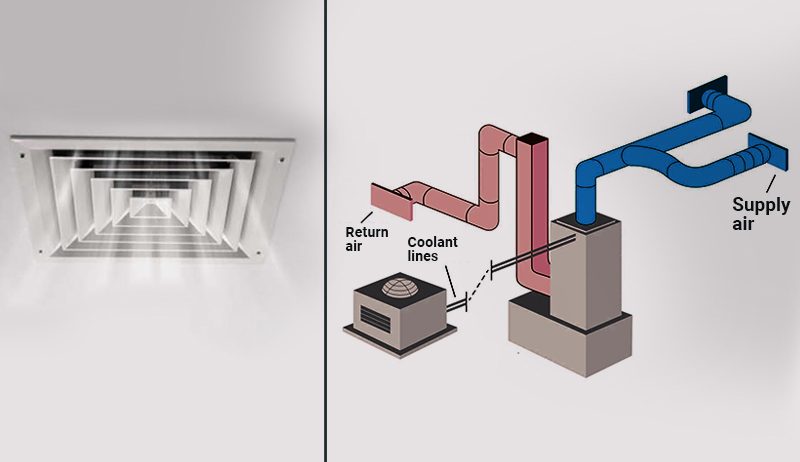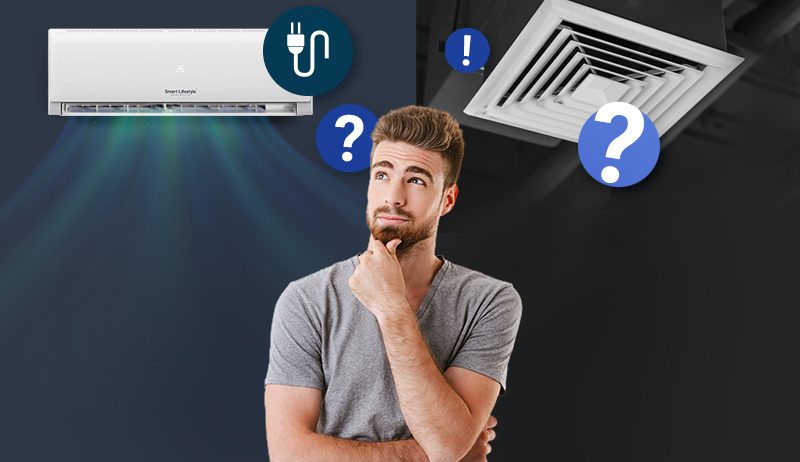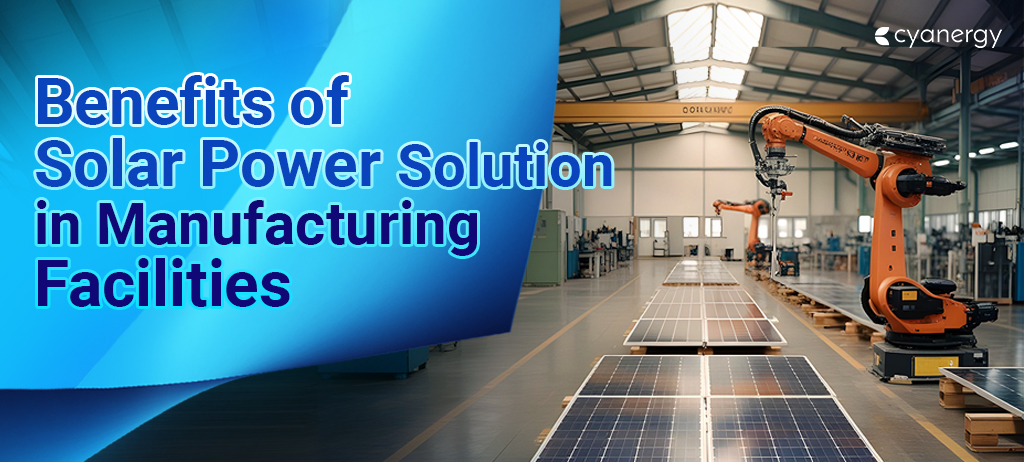It’s common for people to feel stressed when picking the right air conditioner for their home or office. Choosing the best one requires careful steps to get long-term benefits, and many models on the market can be overwhelming and discouraging.
Understanding the differences between reverse cycle and split system air conditioners can be helpful when considering a purchase. These two types are popular in Australia, and knowing their differences will help you select the most suitable option for your needs.
So, what’s the difference between reverse cycle vs split system? Air conditioners are widely used in Australian homes because of the hot summers and cold winters, so heating and cooling make up about 40% of energy bills.
Split systems and reverse-cycle air conditioners are among the most energy-efficient options for cooling and heating.
We will guide you through the essential steps to select an air conditioner that is effective and energy-efficient for your home, giving you a strong sense of control over your comfort and energy costs.
What Makes an Air Conditioner Efficient?
Efficiency in air conditioners is a crucial factor to consider. It can be understood as the balance between the cooling or heating they provide and the electricity they consume.
A more efficient air conditioner delivers more cooling or heating while using less electricity, making it a cost-effective choice.
Larger air conditioners (in terms of their cooling or heating capacity in kilowatts, not their physical size) are usually less efficient. It takes more electricity to deliver a large amount of cooling or heating.
An 8kW unit is less energy-efficient than a smaller 2.5kW unit. However, the 8kW unit can cool or heat a much larger space than the 2.5kW unit. The first step in choosing an efficient air conditioner is to get the right size for your room.
Choosing the Right Size (Cooling/Heating Capacity)
When buying an air conditioner, you might think a more extensive system is better or save money with a smaller one. However, both choices can be wrong. It’s crucial to get the right size for the room.
An air conditioner’s size, or capacity, measures how much cooling or heating it provides and is measured in kilowatts (kW). A small unit (2.5kW) is suitable for a bedroom; a medium unit (5kW) suits a living room; and a large unit (6kW or more) is best for a big open-plan area.
What happens if the air conditioner is the wrong size for the room?
If it’s too big, it might run short cycles to reach the set temperature, making the room too hot or cold, less comfortable, and increasing power use and running costs. It also wears out faster.
If it’s too small, it may need to run at maximum output more often, drying out the air too much, causing more wear and tear, and increasing power use and costs again.
Even if an air conditioner is very efficient, it will only work well if it’s the right size for the room. A good installer like Cyanergy’s installers will calculate the right size, or you can do it yourself.
Star Rating Labels
Residential split-system air conditioners in Australia must meet minimum energy performance standards (MEPS), ensuring that any new model you buy will be reasonably energy-efficient.
When a manufacturer registers a model with the government Energy Rating system, the air conditioner gets a star rating label for cooling and heating based on its test results.
This label is on the model in stores or online, making it easy to compare different models quickly.
Star rating labels help you compare the efficiency of models of the same size. More stars mean the model is more efficient and should cost less if installed correctly.
Even models with one or two stars are acceptable, but those with five or six stars are better, though they might be more expensive.
From April 2020 onwards, new models have a Zoned Energy Rating Label (ZERL), showing three cooling and three heating star ratings based on the climate zone where the unit is used. This helps you choose the best model for your area’s climate.
The three climate zones are:
- Hot: Northern Australia (including Darwin and Brisbane)
- Average: Middle Australia (including Sydney, Adelaide, and Perth)
- Cold: Southern Australia (including Melbourne, southern Western Australia, Tasmania, Canberra, eastern state mountain regions, and New Zealand)
Common Types of Air Conditioners in Australia

There are four main types of air conditioners used in Australia:
Split-systems:
These have indoor and outdoor units connected by pipes with refrigerant gas. They’re the most common type in Australia and are suitable for cooling or heating a room or open-plan area.
Wall/window:
This is a single box unit installed in a window or through an external wall. These are suitable for rooms and open-plan areas. Smaller units can be plugged into a regular power outlet, while larger ones may need extra wiring.
Reverse Cycle:
This system has a central unit. It uses electricity to compress refrigerant until it becomes hot enough to heat the air.
Portable:
These units can be moved from room to room as needed. Most have a flexible duct that needs to be attached to a window to vent the heat outside. Portable air conditioners are sometimes the only option for rooms where built-in options aren’t possible.
How Does Reverse Cycle Air Conditioning Work?
A reverse-cycle split system air conditioner, called a reverse-cycle heat pump, uses the vapour compression refrigeration cycle. It uses electricity to compress refrigerant until it becomes hot enough to heat the air.
Instead of taking air from inside a room and transferring it outside, a reverse cycle air conditioner absorbs air from outside and brings it inside through the refrigeration process. This process works similarly to cooling the air but in reverse, hence the Reverse Cycle.
Because heat is created during this process, expensive heating elements or burning fossil fuels are unnecessary. Electricity from the grid, batteries, or solar panels can be the power source.
How Does a Split System Air Conditioner Work?
A split-system air conditioner is a common type of refrigerant air conditioning. It moves liquid refrigerant through the system to cool the air and, if needed, heat the space.
The system has two parts: an outdoor and indoor compressor unit. The indoor unit, visible inside the home, distributes cool or warm air around the room. It operates using features like filters, a heat exchange coil, a fan, and a remote signal receiver.
Difference Between Split System vs. Reverse Cycle Air Conditioner

You can choose a reverse-cycle or a split-system air conditioner to heat or cool a room. Buying separate heating and cooling appliances can save you money on initial and long-term maintenance costs.
Advantages of Using a Split System Air Conditioner
Easy Maintenance
Split system air conditioners have washable filters that are easy to remove and clean. The outside unit typically doesn’t need cleaning but can be cleaned if required.
Visual Appeal
The indoor unit’s sleek design complements modern home decor. It can be mounted high on the wall, out of direct sight, making it less noticeable.
Low Noise
The indoor unit operates quietly, making it barely noticeable when appropriately positioned.
Temperature Efficient
Split system air conditioners use thermostats to control the temperature, ensuring efficient temperature maintenance.
Energy Efficient
Split systems are energy efficient and usually cost less than ducted air conditioning systems. You can choose which rooms to cool or heat, reducing electricity costs and environmental impact. They also have energy rating labels to help you choose the most efficient model.
Affordable
Split systems are generally cheaper to buy and install compared to ducted air conditioners, making them a more affordable option for many people.
Easy Installation
Installing a split system air conditioner is quick and can typically be done in a day without significant construction work.
A variety Range of Types and Models
There are many brands and models of split-system air conditioners. This variety allows you to select the brand, power output, and cooling or heating capacity that suits your needs.
Advantages of Reverse Cycle Air Conditioners
Warmth During Winter
A reverse-cycle air conditioner provides warmth during cold weather, which is excellent for those in temperate and cold regions of Australia. Unlike traditional electric or gas heaters that create heat, a reverse-cycle system absorbs heat from outside air and brings it inside.
These units have an automatic defrost cycle designed for cold conditions, making them effective even at temperatures as low as 15 degrees Celsius.
Cool During Summer
A reverse-cycle air conditioner can switch to cooling mode with just a switch. It efficiently cools your home by absorbing indoor heat and releasing it outside.
Modern technology allows it to cool homes even at temperatures as high as 46 degrees Celsius, eliminating the need for bulky fans.
Adaptable and Flexible
Modern reverse cycle units are designed for energy efficiency. They have thermostats and advanced inverter technology, which allows them to adapt to room conditions and temperatures.
Inverter technology provides efficient heating and cooling by making gentle power adjustments to quickly reach the desired temperature, unlike conventional air conditioners that turn on and off.
Single Payment, Double Benefit
Installing a reverse cycle system means you pay once for a unit that heats and cools. You can easily switch between modes as needed. This flexibility can significantly reduce cooling and heating costs, especially when you require both functions on different days.
Air Purification
Reverse-cycle air conditioners also help purify the air. Many units have built-in filters that trap fine dust and particles, improving indoor air quality while heating and cooling.
How to Choose Between These Air Conditioners? Seek Expert Advice

While each of these types of air conditioners has advantages for those who are interested in purchasing them, there are some disadvantages that you should consider before making the purchase.
Consult a professional like Cyanergy about your home or office’s cooling and heating requirements. This is the most reliable method for determining which purchase is worth the investment. Get a free quote today, or talk to an expert!







